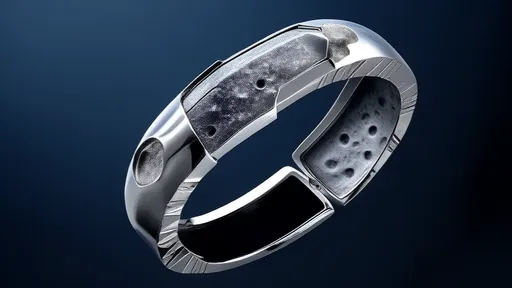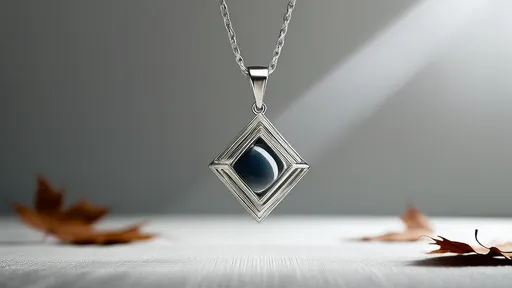The world of wearable technology has taken a fascinating turn with the introduction of balance pendants designed to sync with yoga and meditation practices. These elegant pieces of jewelry are no longer just aesthetic accessories; they have evolved into sophisticated devices that respond to the wearer's breathing patterns. By incorporating advanced sensors and subtle haptic feedback, these pendants create a tangible connection between the body's rhythms and the meditative state, offering a unique tool for both beginners and seasoned practitioners.
At the heart of these balance pendants lies a delicate interplay of technology and mindfulness. Tiny embedded sensors detect the rise and fall of the chest during breathing exercises, translating this physiological data into gentle vibrations or visual cues. The pendant doesn't just monitor breath—it becomes an extension of the breath itself, pulsing in harmony with inhalations and exhalations. This physical manifestation of breath creates a powerful focal point during meditation, helping to anchor wandering thoughts and deepen concentration.
The design philosophy behind these pendants reflects a deep understanding of yogic traditions. Many feature sacred geometry patterns or incorporate materials like copper and crystal believed in Eastern practices to enhance energy flow. Unlike bulky fitness trackers or obvious tech wearables, these pieces maintain the subtle elegance of spiritual jewelry. Some even employ temperature-sensitive materials that change color with prolonged wear, creating a visual diary of one's meditation journey.
Breath awareness forms the cornerstone of numerous meditation techniques, and these pendants amplify that awareness in innovative ways. For practitioners of pranayama—the yogic science of breath control—the device offers real-time feedback on maintaining specific rhythmic patterns. The pendant might gently warm when breath becomes too shallow or emit a soft chime when the ideal 1:2 inhalation-to-exhalation ratio is achieved. This immediate biofeedback helps users develop greater lung capacity and more disciplined breathing without constant mental monitoring.
Clinical studies on similar biofeedback devices suggest promising benefits for stress reduction. When paired with meditation, the physical reminder from the pendant appears to accelerate the body's relaxation response. The parasympathetic nervous system activates more quickly when users can both feel and see their slowing breath patterns. This makes the technology particularly valuable in high-stress environments, offering a discreet way to regain composure during hectic workdays or anxious moments.
Modern iterations of these pendants now incorporate companion apps that track progress over time. The apps don't merely record data—they transform breathing patterns into beautiful visualizations resembling ocean waves or expanding lotus flowers. Some even suggest personalized meditation lengths based on respiratory metrics, adapting to whether the user needs energizing or calming sessions. This digital-physical hybrid creates a holistic system for breath mastery that bridges ancient wisdom with contemporary technology.
Ethical considerations have emerged alongside the technology's growth. Traditionalists question whether mechanizing such an intimate aspect of spiritual practice risks diminishing the human element. Manufacturers counter that these are assistive tools, not replacements for disciplined practice—comparable to using blocks in yoga poses. The most thoughtful designs incorporate "silent modes" that allow experienced users to wean off the feedback gradually as their breath awareness deepens.
Future developments point toward even more seamless integrations. Prototypes in research labs explore pendants that adjust room lighting based on breath patterns or sync with sound baths during group meditation. Other experimental models use advanced materials that actually weigh slightly more during exhalation and lighter during inhalation—creating a literal physical balance that mirrors the respiratory cycle. As the technology matures, it may redefine how we approach the fundamental connection between breath, movement, and mental states.
The cultural reception of these devices varies interestingly across markets. In Western countries, they're often marketed as high-tech wellness accessories, while Eastern markets emphasize their alignment with traditional healing arts. This dichotomy reflects broader conversations about how technology intersects with spiritual practices. Regardless of perspective, the core value remains: these pendants make the invisible breath visible, turning an automatic bodily function into a conscious pathway to balance.
For those exploring meditation or seeking to deepen their practice, breath-sensing pendants offer a compelling middle ground between ancient techniques and modern innovation. They serve as both training wheels for beginners and refined instruments for advanced practitioners. In a world where stress has become epidemic, such tools that gently guide us back to the wisdom of the breath may prove invaluable. The true measure of their success lies not in their technological sophistication, but in how effectively they help wearers disconnect from external chaos and reconnect with internal rhythm.

By /Jul 15, 2025

By /Jul 15, 2025

By /Jul 15, 2025

By /Jul 15, 2025

By /Jul 15, 2025

By /Jul 15, 2025

By /Jul 15, 2025

By /Jul 15, 2025

By /Jul 15, 2025

By /Jul 15, 2025

By /Jul 15, 2025

By /Jul 15, 2025

By /Jul 15, 2025

By /Jul 15, 2025

By /Jul 15, 2025

By /Jul 15, 2025

By /Jul 15, 2025

By /Jul 15, 2025